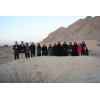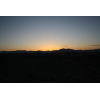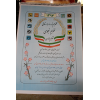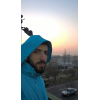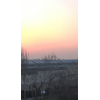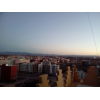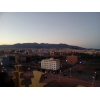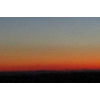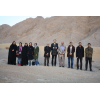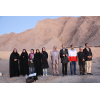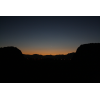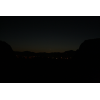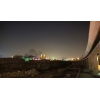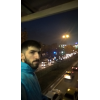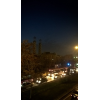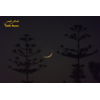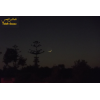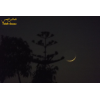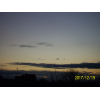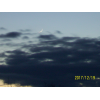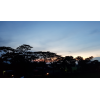Visibility of Rabee' Al-Aakher Crescent 1439 AH
- When to Observe Rabee' Al-Aakher Waxing (NEW) Crescent ?
- Rabee' Al-Aakher Waxing (NEW) Crescent Observation Results
- The OFFICIAL First Day in Different Countries
- When to Observe Rabee' Al-Awwal Waning (OLD) Crescent ?
- Rabee' Al-Awwal Waning (OLD) Crescent Observation Results
When to Observe Rabee' Al-Aakher Waxing (NEW) Crescent ?
The geocentric conjunction (Geocentric New Moon) will occur Inshalla on (Monday 18 December 2017) at 06:30 UT.
Sighting the new crescent on (Monday 18 December 2017) and (Tuesday 19 December 2017) is shown in the below graphs using the program Accurate Times by Mohammad Odeh according to Odeh criterion. Where:-
- It is impossible to see the crescent from the areas located under the red color. Because either the Moon on this day sets before the Sunset and/or the topocentric conjunction occurs after the Sunset.
- The crescent is expected to be seen by optical aid only from the areas located under the blue color.
- The crescent is expected to be seen by optical aid from the areas located under the magenta color. In these areas the crescent could be seen by naked eye if the atmospheric conditions are superb and the observer is experienced.
- The crescent is expected to be easily visible by naked eye from the areas located under the green color.
- The crescent cannot be seen from uncolored areas, even though the Moon sets in these locations after the Sunset and the topocentric conjunction occurs before the Sunset, but the Moon is not sufficiently illuminated in order to be seen as crescent even by optical aid.
- Kindly notice that the below graph shows the possibility of seeing the crescent from areas between 60 degrees north of Equator down to 60 degrees south of Equator.
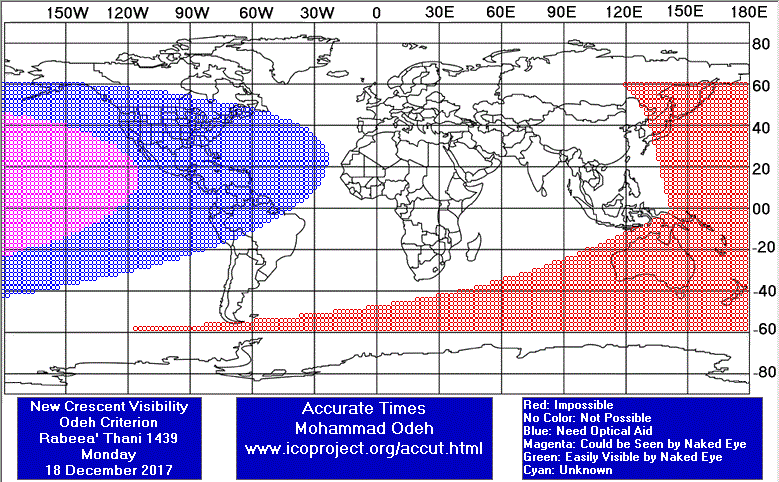

According to the Universal Hejric Calendar (UHC), which is based on the calculated crescent visibility, the start of this month in the Eastern Region will be on Wedensday 20 December 2017 and in the Western Region will be on Tuesday 19 December 2017. Kindly notice that the UHC is a pre-calculated calendar, which adopts a certain criterion to start the new Hejric month. Your country/organization might adopt different criterion to start the new Hejric month. So it is highly advised to read the UHC website before giving any judgment.
- Results of seeing the crescent, and the first day of the month in different countries will be added here Inshalla as we receive the reports from ICOP's members. If you wish to be a member in ICOP, or to know more about it, kindly click here.
Rabee' Al-Aakher Waxing (NEW) Crescent Observation Results
Mon 18 December 2017
Indonesia
Mr. AR Sugeng Riyadi said: "The new crescent of Rabiul Akhir 1439 AH was not sighted on Monday, 18 December 2017 from Rowasiya Observatory at Bendo Ketitang Juwiring Klaten Central Java Indonesia. The sky was totally cloudy."
Iran
Mr. Hossein Janghorbani said: "In the name of God Rabee' Al-Aakher Crescent Observation Report The Astronomy and Geophysics Center of Shahreza – The Crescent Association of Shahreza Report by: Hossein Janghorbani (Najmosepehr-Sadrolmonajjemin) – Manager of Shahreza Crescent Association and Red Crescent’s Astronomy and Geophysics Center Date: Monday, 12/18/2017 Location: Damzad foothills in the East of Shahreza (latitude: 32 00 N, longitude: 51 52 E, elevation: 1825m from sea level, time zone: +3.5 GMT) Equipments: Two sets of 15*70 binoculars, One sets of 20*90 binoculars, One sets of 25*100 binoculars, One compass. Atmospheric condition: hazy. Horizon obstacles: 2° Apparent sunset: 16:52 Results: Moon crescent was not seen by naked eye, Moon crescent was not seen by binocular. At the end of this scientific program, the seventh Yalda Night Festival on the occasion of the advent of the sun to the point of the Winter Revolution and The longest night of the year was celebrated and the astronomical calendar of 1397 was unveiled by Mr Hossein Janghorbani. Observers: 1.Mohammad Javad Nikeghbal 2.Mohammad Sadra Nikeghbal 3. Saer Aliabedi 4.Ali Janghorbani 5. Hossein Janghorbani 6.Narjes Zare 7.Mohadeseh Alinezhad 8.Ezat Nazariat 9. .Parisa Ghadimi 10.Shahideh Torabi 11.Toktam Aliabedi 12.Masoomeh Hafar 13.Ziba Hafar 14.Fatemeh Tavakoli 15.Zahra Fallahi "
Mr. Hossein Janghorbani said: "Mr.Reza Janghorbani based in the city of Tabriz in East Azerbaijan province due to hazy weather, Not see the crescent moon."
Morocco
Mr. Abdessamad Doukkane said: "راقبت جمعية المبادرة المغربية للعلوم والفكر هلال ربيع الثاني مساء يوم الاثنين 18 دجنبر مع مندوبية الاوقاف والشؤون الاسلامية بالناظور. وتمت المراقبة بصومعة المسجد الكبير بحي المطار, ولم تثبت رؤية الهلال, كما أشارت جمعية المبادرة المغربية للعلوم والفكر في بيانها, وكان إرتفاعها 49 متر عن البحر"
South Africa
United States
Dr. Javad Torabinejad said: "I arrived at my sighting location at 5:28 pm EST (sunset: 5:07 pm). While based on the visibility curves not expecting to sight the crescent, using a pair of binoculars (7X50), I started scanning a mostly clear west southwestern horizon. I did not see the moon. I ended the session at 5:47 pm (moonset: 5:45 pm)."
Tue 19 December 2017
Hungary
Indonesia
Mr. AR Sugeng Riyadi said: "The new crescent of Rabiul Akhir 1439 AH was not sighted on Tuesday, 19 December 2017 from Rowasiya Observatory at Bendo Ketitang Juwiring Klaten Central Java Indonesia. The sky was totally cloudy."
Iran
Mr. Hossein Janghorbani said: "In the name of God Rabee' Al-Aakher Crescent Observation Report The Astronomy and Geophysics Center of Shahreza – The Crescent Association of Shahreza Report by: Hossein Janghorbani (Najmosepehr-Sadrolmonajjemin) – Manager of Shahreza Crescent Association and Red Crescent’s Astronomy and Geophysics Center Date: Tuesday, 12/19/2017 Location: Damzad foothills in the East of Shahreza (latitude: 32 00 N, longitude: 51 52 E, elevation: 1825m from sea level, time zone: +3.5 GMT) Equipments: Two sets of 15*70 binoculars, One sets of 7*50 binoculars, One compass. Atmospheric condition: hazy. Horizon obstacles: 2° Apparent sunset: 16:52 Results: Moon crescent was seen by naked eye by Hossein Janghorbani at 17:05, for the first time. Other group members observed crescent by binoculars and by naked eye subsequently. Observers: 1. Dr AliAkbar Taki 2. Mohammad Reza Kazemi 3. Mohammad Javad Nikeghbal 4. Mohammad Sadra Nikeghbal 5.Ali Janghorbani 6. Hossein Janghorbani 7.Narjes Zare 8.Ezat Nazariat 9. .Parisa Ghadimi 10.Ziba Hafar 11.Zinat Ghermezi 12.Zahra Fallahi "
Mr. Hossein Janghorbani said: "Mr.Reza Janghorbani based in the city of Tabriz in East Azerbaijan province due to hazy weather, Not see the crescent moon."
Morocco
United Kingdom
Eng. Qamar Uddin said: "I was able to locate the correct position of the moon in the sky using binoculars (10x50) and I saw it about 4.30 pm and then by naked eye about 10 mins later (4.40 pm) - see photos. "
United States
Dr. Javad Torabinejad said: "I arrived at my sighting location at 4:59 pm EST (sunset: 5:08 pm). The western horizon was partly cloudy. Using a pair of binoculars (7X50), I started scanning the horizon. The first binocular sighting was at 5:02 pm (before sunset) followed by the first naked eye sighting at 5:08 pm. The horns were at 2:30 and 7:00 O'clock (2:30;4:00;7:00). I left the site at 5:44 pm (moonset: 6:33 pm)."
The OFFICIAL First Day in Different Countries
Wed 20 December 2017
1 . Indonesia
2 . Iran
3 . Morocco
4 . South Africa
5 . United Kingdom
When to Observe Rabee' Al-Awwal Waning (OLD) Crescent ?
The geocentric conjunction (Geocentric New Moon) will occur Inshalla on (Monday 18 December 2017) at 06:30 UT.
Sighting the OLD crescent on (Monday 18 December 2017) and (Sunday 17 December 2017) is shown in the below graphs using the program Accurate Times by Mohammad Odeh according to Odeh criterion. Where:-
- It is impossible to see the OLD crescent from the areas located under the red color. Because either the Moon on this day rises after the Sunrise and/or the topocentric conjunction occurs before the Sunrise.
- The crescent is expected to be seen by optical aid only from the areas located under the blue color.
- The crescent is expected to be seen by optical aid from the areas located under the magenta color. In these areas the crescent could be seen by naked eye if the atmospheric conditions are superb and the observer is experienced.
- The crescent is expected to be easily visible by naked eye from the areas located under the green color.
- The crescent cannot be seen from uncolored areas, even though the Moon rises in these locations before the Sunrise and the topocentric conjunction occurs after the Sunrise, but the Moon is not sufficiently illuminated in order to be seen as crescent even by optical aid.
- Kindly notice that the below graph shows the possibility of seeing the crescent from areas between 60 degrees north of Equator down to 60 degrees south of Equator.
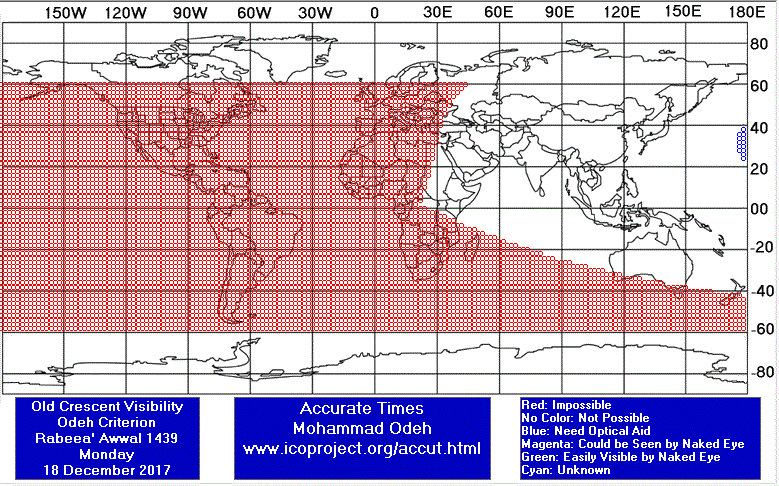
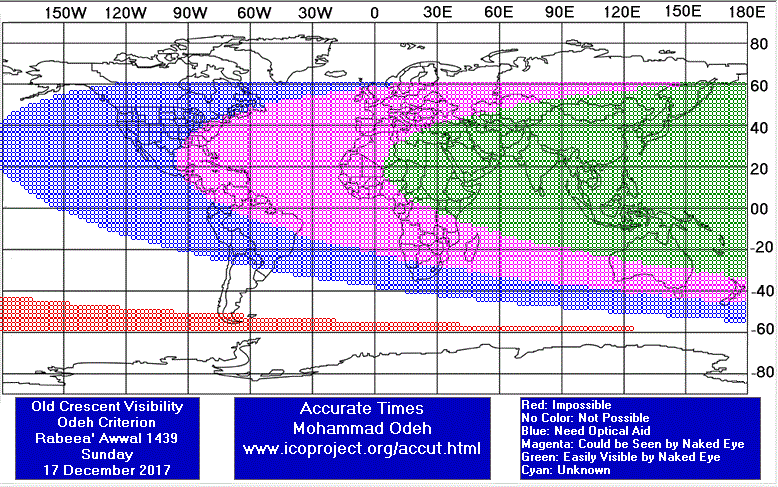
Rabee' Al-Awwal Waning (OLD) Crescent Observation Results
Sun 17 December 2017
Indonesia
Mr. AR Sugeng Riyadi said: "The old crescent of Rabiul Awal 1439 AH was not sighted on Sunday, 17 December 2017 from Rowasiya Observatory at Bendo Ketitang Juwiting Klaten Central Java Indonesia. The sky was totally cloudy."
Mon 18 December 2017
Indonesia
Mr. AR Sugeng Riyadi said: "The old crescent of Rabiul Awal 1439 AH was not sighted on Monday, 18 December 2017 from Rowasiya Observatory at Bendo Ketitang Juwiting Klaten Central Java Indonesia. The sky was totally cloudy."
